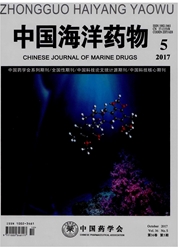

 中文摘要:
中文摘要:
目的采用新型gc2hsqcse二维核磁共振技术对绿藻硫酸多糖Ls25进行结构解析。方法对从绿藻中分离纯化得到的硫酸多糖Ls25进行理化性质分析,并通过红外光谱、甲基化分析以及核磁共振1 H NMR、^1H-PRESET、^(13)C NMR、^1H-1 H COSY、^1H-^(13)C HSQC、^1H-^(13)C gc2hsqcse和^1H-^(13)C HMBC对其进行结构表征。对传统HSQC和新型gc2hsqcse核磁共振技术采用相同采集时间、驰豫时间和扫描次数等,gc2hsqcse在脉冲序列中加入宽带反转脉冲。结果硫酸多糖Ls25的分子量为64.2kDa,硫酸基含量为29.7%,其主要由鼠李糖(91.95%)组成,含有少量葡萄糖醛酸和木糖。在核磁共振分析中二维HSQC谱图中信号缺失严重,采用宽带反转脉冲gc2hsqcse,得到了在HSQC谱图中缺失的糖基A、B、C和D等信号。结合甲基化分析及其他一维和二维核磁共振谱图分析,完成糖基信号的全归属,最终确定Ls25的结构特征。结论采用新型gc2hsqcse二维核磁共振测试技术,解决了硫酸多糖在二维HSQC谱图中的信号缺失问题,为硫酸多糖的结构解析带来了新技术新方法。
 英文摘要:
英文摘要:
Objective To study the structure of sulfated polysaccharide Ls25 using a new type of gc2hsqcse two dimensional nuclear magnetic resonance (NMR) technology. Methods The physicochemi- cal properties of the green alga sulfated polysaccharide Ls25 were analyzed. The structure of Ls25 was characterized by infrared spectroscopy (IR), methylation analysis and NMR spectroscopy including 1H NMR,1 H-PRESET, 13C NMR, 1H-1H COSY,1H- lzC HSQC, 1H- 13 gc2hsqese and 1H- 13C HM- BC. The traditional HSQC and the new gc2hsqcse NMR were carried out in the same acquisition time,relaxation time, scanning times and so on. The pulse sequence with the broadband inversion pulse was added to the gc2hsqcse NMR. Results The molecular weight of the sulfated polysaccharide Ls25 was a- bout 64. 2 kDa and its sulfate content was 29. 7~. Ls25 was mainly composed of rhamnose (91.95~) with small amounts of glucuronic acid and xylose. The signals of the sugar residues A, B, C and D lacked in the traditional HSQC spectrum were obtained by gc2hsqcse with the broadband inversion pulse. Combined with methylation analysis, one and two-dimensional nuclear magnetic resonance spec- troscopy, the full attribution of the sugar residue signals were completed. The structure of Ls25 was characterized. Conclusion To solve the problem of signal loss in the traditional two-dimensional HSQC of sulfated polysaccharides, a new type of gc2hsqcse two-dimensional NMR technique was used. A new technique and method for the structural analysis of sulfated polysaccharide was developed.
 同期刊论文项目
同期刊论文项目
 同项目期刊论文
同项目期刊论文
 期刊信息
期刊信息
